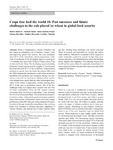Mostrar el registro sencillo del ítem
Crops that feed the world 10. Past successes and future challenges to the role played by wheat in global food security
| Autor: | Shiferaw, B. |
| Autor: | Smale, M. |
| Autor: | Braun, H.J. |
| Autor: | Duveiller, E. |
| Autor: | Reynolds, M.P. |
| Autor: | Muricho, G. |
| Año: | 2013 |
| ISSN: | 1876-4517 |
| URI: | http://hdl.handle.net/10883/3468 |
| Resumen: | Wheat is fundamental to human civilization and has played an outstanding role in feeding a hungry world and improving global food security. The crop contributes about 20 % of the total dietary calories and proteins worldwide. Food demand in the developing regions is growing by 1 % annually and varies from 170 kg in Central Asia to 27 kg in East and South Africa. The developing regions (including China and Central Asia) account for roughly 53 % of the total harvested area and 50 % of the production. Unprecedented productivity growth from the Green Revolution (GR) since the 1960s dramatically transformed world wheat production, benefitting both producers and consumers through low production costs and low food prices. Modern wheat varieties were adopted more rapidly than any other technological innovation in the history of agriculture, recently reaching about 90 % of the area in developing regions. One of the key challenges today is to replace these varieties with new ones for better sustainability. While the GR ?spared? essential ecosystems from conversion to agriculture, it also generated its own environmental problems. Also productivity increase is now slow or static. Achieving the productivity gains needed to ensure food security will therefore require more than a repeat performance of the GR of the past. Future demand will need to be achieved through sustainable intensification that combines better crop resistance to diseases and pests, adaptation to warmer climates, and reduced use of water, fertilizer, labor and fuel. Meeting these challenges will require concerted efforts in research and innovation to develop and deploy viable solutions. Substantive investment will be required to realize sustainable productivity growth through better technologies and policy and institutional innovations that facilitate farmer adoption and adaptation. The enduring lessons from the GR and the recent efforts for sustainable intensification of cereal systems in South Asia and other regions provide useful insights for the future. |
| Formato: | |
| Lenguaje: | English |
| Editor: | Springer Verlag |
| Copyright: | CIMMYT manages Intellectual Assets as International Public Goods. The user is free to download, print, store and share this work. In case you want to translate or create any other derivative work and share or distribute such translation/derivative work, please contact CIMMYT-Knowledge-Center@cgiar.org indicating the work you want to use and the kind of use you intend; CIMMYT will contact you with the suitable license for that purpose. |
| Tipo: | Article |
| Lugar de publicación: | Netherlands |
| Páginas: | 291-317 |
| Número: | 3 |
| Volumen: | 5 |
| DOI: | 10.1007/s12571-013-0263-y |
| Palabras Claves: | Utilization |
| Palabras Claves: | Technology Adoption |
| URI del Editor : | http://link.springer.com/article/10.1007%2Fs12571-013-0263-y |
| País: | CENTRAL ASIA |
| País: | EAST AFRICA |
| País: | SOUTH AFRICA |
| País: | CHINA |
| Agrovoc: | FOOD SECURITY |
| Agrovoc: | DEMAND |
| Agrovoc: | SUPPLY |
| Agrovoc: | USES |
| Agrovoc: | PRODUCTIVITY |
| Agrovoc: | GROWTH |
| Agrovoc: | CLIMATE CHANGE |
| Agrovoc: | WHEAT |
| Revista: | Food Security |
Ficheros en el ítem
Este ítem aparece en la(s) siguiente(s) colección(ones)
-
Wheat
Wheat - breeding, phytopathology, physiology, quality, biotech

